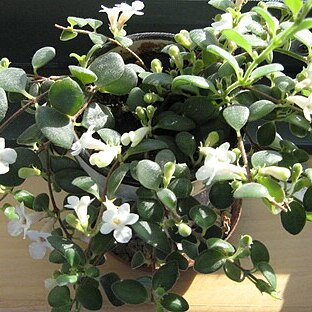Epiphytic shrubs or lianas or herbs, usually growing on ants' nests; branches few, stems pendent, repent, or erect, to 2 m tall, becoming woody; adventitious roots and/or extrafloral nectaries sometimes produced from the nodes. Leaves opposite, equal to rarely strongly unequal in a pair; blades fleshy, becoming coriaceous when dry, entire, sinuate or serrulate toward the apex, often with reddish extrafloral nectaries on the lower surface; petioles usually short. In-florescences of one or few flowers in the upper leaf axils; peduncles, if present, very short; bracts lacking; pedicels short. Flowers with the calyx 5-lobed or bi-labiate, when 5-lobed the lobes nearly equal to very unequal, the dorsal lobe often recurved; corolla white, pink, lilac, yellow, or deep purplish, often with reddish lines or spots, oblique in the calyx, the tube funnelform to subcampanu-late, the base spurred or rounded, gradually or abruptly broader toward the throat, or somewhat compressed or grooved, the limb spreading, of 5 rounded lobes; stamens 4, inserted at the base of the corolla tube, included, the filaments adnate to the base of the corolla tube, briefly connate at the base, recoiled or lowered after pollen shed, the anthers laterally oblong, coherent in pairs by tips or sides, later separating, dehiscing by pores; disc a single dorsal nectary, usually large; ovary superior with 2 parietal placentas ovuliferous on the inner side, the style included but elongating after pollen shed, the stigma bilobed to stomato-morphic. Fruit a fleshy berrylike capsule, tardily dehiscent or dehiscing by 2 valves, globose, ovoid, or compressed, red, pink, orange, or yellow green; seeds colored red, pink, or yellow, fusiform or ellipsoid, obliquely striate, the funicle often fleshy or the seed surrounded by an ari]. Chromosomes n = 8 or 16 (Wiehler, 1975b).
More
Epiphytic, usually growing on ant-nests, caulescent, pendent, repent, to erect herbs, shrubs, or lianas, without modified stems. Stems branched or unbranched. Leaves opposite, equal to rarely strongly unequal in a pair, venation pinnate, foliar nectaries present on lower leaf surface. Flowers axillary, solitary or in cymose few-flowered inflorescences; epedunculate or very short-pedunculate; bracteoles absent; short pedicellate. Calyx lobes 5, nearly free or briefly connate at base, or united into 2 lobes (C. calcarata); corolla white, pink, lilac, yellow, or deep purplish, often with reddish lines or spots, funnel-shaped to subcampanulate, limb 5-lobed; stamens included, filaments basally connate, anthers coherent in pairs by tips or sides, later separating, dehiscing by apical pores, thecae separated by broad connectives; staminode very small; disc a single dorsal, usually large gland; ovary superior, stigma stomatomorphic to 2-lobed. Fruit a fleshy, indehiscent, red, pink, orange, or yellow-green berry (in Guianan species).

